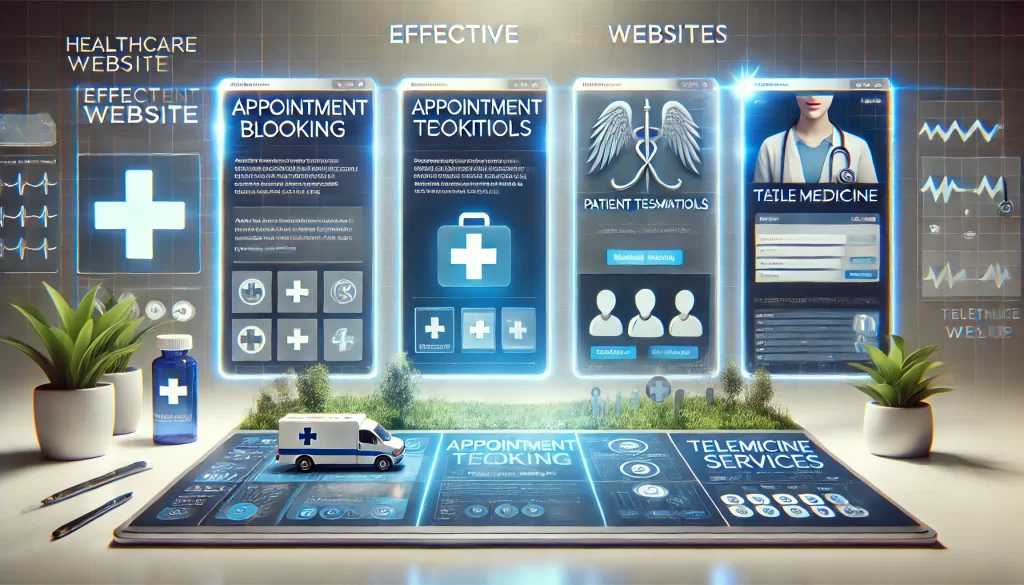Introduction
When it comes to healthcare websites, design is much more than just an aesthetic choice. It’s about creating a digital space that serves both the practical and emotional needs of users. Whether the website is for a hospital, clinic, wellness center, or health coach, it should foster trust, be easy to navigate, and provide essential information in a clear and accessible manner. We will showcase some examples of effective healthcare websites that exemplify best practices in design, content, user experience (UX), and conversion strategies. These websites have set the bar for what a high-performing healthcare site should look like and serve as models for others in the industry.
From major health institutions to specialized wellness and fitness platforms, we will explore how these sites integrate engaging content, SEO-friendly strategies, and user-centered design principles to create the ultimate online experience.

Top Healthcare Websites – Best Practices and Insights
Mayo Clinic – A Model of Trust and Clarity
The Mayo Clinic website is consistently ranked as one of the best healthcare websites, and for good reason. Its design focuses on accessibility and clear navigation, making it easy for patients and visitors to find essential health information. Here’s why it works:
- Clear, Organized Content: Information is categorized by conditions, services, specialties, and patient care, making it straightforward for users to navigate.
- Trust-Building Features: The site features prominent links to patient testimonials, research, and its global reputation for high-quality care. This reinforces trust and authority in the medical field.
- Patient-Centered Design: With an easy-to-use appointment scheduling system and a detailed “find a doctor” feature, Mayo Clinic’s website emphasizes conversion optimization.
For those designing healthcare websites, Mayo Clinic’s site is a prime example of how to balance clinical authority with user experience (UX), ensuring the site is both practical and approachable for visitors.
Cleveland Clinic – Combining Functionality with Visual Appeal
Cleveland Clinic’s website excels in balancing functional navigation and visual appeal. The homepage is clean, and the search bar is centrally placed for easy access to services, health advice, and physician directories. Here’s what sets Cleveland Clinic apart:
- Mobile-Optimized Experience: The website provides an excellent mobile version, making it user-friendly across all devices. This is critical as many visitors today access healthcare websites through smartphones.
- SEO-Focused Content: Cleveland Clinic has a rich content library that ranks highly on Google, thanks to well-optimized articles on health tips, treatment options, and the latest medical research.
- Real-time Chat Support: The addition of a chatbot allows visitors to ask questions and get real-time help, ensuring a high level of user engagement.
The Cleveland Clinic site demonstrates the importance of balancing visually appealing design with functional elements like real-time communication and robust, searchable content.
Related Posts
- Email Marketing for Healthcare Professionals
- Digital Marketing Strategies for Healthcare Websites
- Online Courses and Resources
Healthline – Leading the Charge in Content-Driven Design
When it comes to health and wellness content, Healthline is one of the most visited websites globally. It’s an example of how content-driven design can boost both traffic and user engagement. Here are the highlights:
- Comprehensive Health Guides: Healthline provides in-depth articles on a range of medical topics, written by experts and backed by scientific research.
- SEO Excellence: By using high-quality keywords related to healthcare platforms, such as “mental health,” “nutrition,” and “chronic conditions,” Healthline ensures that its content ranks highly on search engines.
- User-Focused Features: A search tool for conditions and symptoms, interactive quizzes, and expert opinions make Healthline both informative and interactive.
For healthcare websites, Healthline offers a solid lesson in leveraging SEO best practices while ensuring content quality and readability. It exemplifies how to attract visitors through engaging content while providing actionable insights.

Specialized Healthcare Websites – Tailoring Design for Niche Audiences
Talkspace – Digital Mental Health Services
As a leader in the digital mental health space, Talkspace is an excellent example of a specialized healthcare website. The site caters specifically to individuals seeking therapy and counseling online, providing:
- Targeted User Experience: The layout and content are personalized to mental health patients, offering easy access to therapy options, articles on mental health, and blog posts.
- Conversion-Focused Design: The homepage prominently displays a call-to-action for users to “Get Started” with online therapy, and the sign-up process is simple and clear.
- Trust and Safety: The website uses reassuring language like “secure and confidential” to build trust. It also features testimonials from satisfied clients, reinforcing its credibility.
For mental health websites, Talkspace sets the standard for how to focus on user needs while providing a streamlined conversion process.
Peloton – Merging Health, Fitness, and Wellness
The Peloton website demonstrates how health and fitness websites can excel in user engagement and conversion optimization. Peloton’s design principles can be applied to any wellness platform:
- Strong Brand Identity: The color scheme and imagery on Peloton’s site convey energy and vitality, effectively reinforcing its brand.
- Seamless E-Commerce Experience: Peloton integrates product sales (bikes, accessories) into the user journey without being intrusive. It’s easy for users to explore, try, and buy the product.
- Effective CTAs: “Get Started” and “Join the Movement” are direct calls-to-action that draw users deeper into the sales funnel.
For health and fitness websites, Peloton showcases how to leverage visual branding and e-commerce within a wellness site while prioritizing conversion and user experience.
Related Posts
- Additional Resources for Healthcare Website Design
- Social Media Strategies for Holistic Health Websites
- Alternative and Natural Health Websites
Top Health Websites to Learn From
WebMD – Comprehensive Health Information at Your Fingertips
WebMD is one of the most popular health websites on the internet. Known for its extensive collection of health resources, it is a go-to website for millions of users. Here’s how it stands out:
- Extensive Resource Library: WebMD offers detailed articles, video content, and symptom checkers, making it a rich resource for anyone seeking health information.
- Interactive Tools: The website offers tools like the Symptom Checker and drug information database, helping users take action based on their health needs.
- Authoritative Content: WebMD’s content is written by medical professionals and reviewed by doctors, which builds trust with users.
For healthcare websites, WebMD serves as an example of how to deliver authoritative, comprehensive content while remaining accessible and easy to navigate.
FAQs
What are the best healthcare websites?
Some of the top healthcare websites include Mayo Clinic, Cleveland Clinic, and Healthline. These websites excel in user experience, content quality, and design.
What makes a healthcare website effective?
An effective healthcare website is user-friendly, mobile-responsive, and focuses on providing clear, actionable content. It should also prioritize conversion optimization through strategic calls-to-action.
How can healthcare websites improve SEO?
Healthcare websites can improve SEO by incorporating relevant keywords, creating high-quality content, optimizing for mobile, and providing valuable, accurate information that addresses user needs.
What design elements build trust on a healthcare website?
Trust-building design elements include easy navigation, professional branding, patient testimonials, and transparent information about services, privacy policies, and certifications.
Key Takeaways
In the competitive world of healthcare, a website is often the first point of contact with potential patients or clients. Effective healthcare websites go beyond a functional design to create a user experience that is informative, engaging, and built on trust. The top healthcare websites, such as Mayo Clinic, Cleveland Clinic, and Healthline, serve as exemplary models of how design, content, and functionality can come together to build a comprehensive online presence. Whether you’re designing a website for a medical facility, wellness center, or mental health platform, understanding the best practices from these leaders will help you create a successful online experience.
- Effective healthcare websites prioritize user experience (UX), with intuitive navigation and mobile-friendly design.
- Content-driven sites like Healthline excel in SEO and authoritative health information.
- Conversion optimization, through clear CTAs and easy user flows, is essential for healthcare websites.
The visual design of healthcare websites should reinforce trust and be aligned with the organization’s brand.
